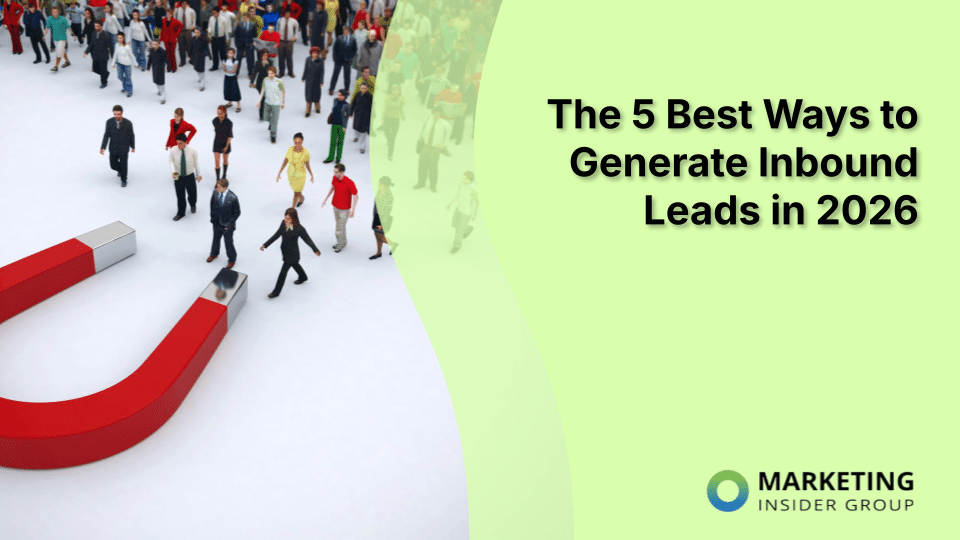
If you’ve ever felt like you’re constantly chasing customers and trying to convince them to come speak with you, you’re not alone. Outbound marketing still has its place, but it’s expensive, time-consuming, and often ignored. That’s why so many businesses in 2026 are turning their focus to inbound lead generation – creating systems that attract, engage, and convert prospects organically.
To put it simply, inbound leads are different. They’re already interested and searching for solutions. You could say they’re already halfway through the buying journey before they even reach you. And when your strategy is dialed in, it feels effortless. In a way, your ideal clients start finding you, instead of the other way around.
While strategies are always emerging and evolving, here are five of the most effective ways top marketers are generating inbound leads in 2026.
1. Create Value-First Content That Actually Solves Problems
If you want inbound leads, you need to earn attention. And the best way to do that is by creating content that genuinely helps your audience.
The era of shallow blog posts and keyword-stuffed articles is over. (It might have worked 10 years ago, but Google is on to us now.) In 2026, people (and search engines) reward content that offers real substance. This includes rich resources, tutorials, frameworks, and case studies that solve real-world problems.
Think about your ideal customer. What are they trying to accomplish? What are they frustrated by? Every piece of content you create should address those questions directly.
That could mean:
- Writing an in-depth blog post that breaks down a complex concept in simple terms
- Creating a short video series that teaches a process step-by-step
- Publishing industry reports with original data that positions you as a thought leader
At the end of the day, the goal is to build trust. You want to think about your content creation through that filter. When someone reads your content and thinks, “They really understand what I’m dealing with,” they’re far more likely to reach out or subscribe.
And the beauty of value-driven content is that it keeps working long after you publish it. A single high-performing article or video can generate leads for months or even years.
2. Optimize for Organic Search (But Smarter)
Search engine optimization (SEO) has evolved dramatically – and in 2026, the winners are the ones who think strategically.
Modern SEO is less about gaming algorithms and more about matching search intent. When someone types a question into Google or speaks it into a voice assistant, your goal is to be the most relevant, trustworthy, and clear answer available.
That means going beyond keywords and optimizing for things like topic clusters that can allow you to establish authority across entire subjects (rather than just a single post here and there). You also need human-first language that sounds super conversational (because voice search is now everywhere)
3. Use Link Building to Supercharge Visibility
Even the best content won’t perform if no one can find it. That’s where link building comes in – and in 2026, it’s one of the most effective ways to strengthen your inbound marketing engine.
Search engines view backlinks as votes of confidence. When reputable sites link to your content, it tells Google (and your audience) that your business is worth paying attention to.
The challenge is that building high-quality links takes lots of time and behind-the-scenes strategy. That’s why many top marketers now work with specialized link building agencies that know how to identify opportunities, pitch editors, and secure placements that move the needle.
These agencies handle outreach and content partnerships so that you can focus on running your business. A good team will tailor their link building strategies to your specific goals, ensuring every backlink strengthens your SEO foundation and brings more inbound leads your way.
4. Nurture Leads Through Automation and Personalization
Generating inbound leads is only half the battle – nurturing them is where the real magic happens. Once someone downloads a guide or fills out a contact form, you need to guide them from interest to decision without overwhelming them.
In 2026, people know when they’re getting generic content, and they tune out fast. That’s why modern lead nurturing has to be built around smart automation that’s capable of delivering the right message at the right time.
For example:
- A new subscriber gets a personalized welcome sequence with content tailored to their interests
- A repeat visitor sees dynamic website content that reflects what they’ve already viewed
- A lead that downloads a pricing guide receives a follow-up email with a relevant case study
With the right automation tools, you can scale your communication while still keeping it personal. That’s how you build trust and stay top of mind…without having to manually follow up with every single lead.
5. Turn Social Media into a Conversation Engine
Social media is one of the most powerful inbound lead generators you have, if you use it strategically.
Instead of blasting promotional posts, focus on community and connection. People want to engage with real voices, not faceless companies. With this in mind, do your best to share behind-the-scenes moments and insights that humanize your brand.
Platforms like Instagram and TikTok are now built around engagement-driven algorithms, meaning thoughtful conversations often outperform flashy ads.
But no matter what platform you use, consistency is key. Showing up regularly with valuable, human-centered content builds familiarity. Don’t expect to post once per week, and then leverage your socials as some powerful marketing weapon that generates leads. You have to show up regularly.
6. Leverage AI Tools to Accelerate Your Inbound Engine
By 2026, AI isn’t a shiny add-on anymore—it’s the core of how high-growth companies scale inbound results without ballooning their marketing teams. The brands leading the inbound landscape today use AI not to replace human creativity, but to amplify it. They’re using smart tools to analyze behavior patterns, identify hidden opportunities, and optimize content performance at a pace no human team could match alone.
For example, AI can map out the exact questions your ideal customers are asking online, then help you structure content that aligns perfectly with those search behaviors. It can show you which pages are leaking conversions, which topics generate the highest-quality leads, and which segments respond best to specific messages. Instead of relying on guesswork, you’re making decisions based on millions of real data points.
AI-driven content tools can also streamline production. Rather than starting each article, email, or landing page from scratch, your team can generate outlines, refine messaging, or repurpose existing content efficiently—freeing you up to focus on strategy, storytelling, and thought leadership.
And the real advantage? AI makes iteration effortless. You can test headlines, CTAs, email sequences, and even entire content funnels in real time. The faster you learn what works, the faster you convert leads. When you combine AI insights with human creativity and strategic oversight, you create a compounding effect that dramatically improves inbound lead flow.
Bringing It All Together
Inbound lead generation in 2026 is all about creating genuine value and meeting people where they are.
That means blending smart SEO with meaningful content, strategic link building, and a tactful approach to social media. When these pieces work together, you create a flywheel where every new lead fuels the next opportunity.

